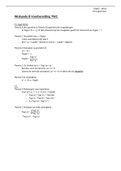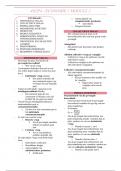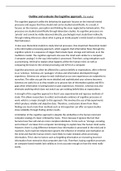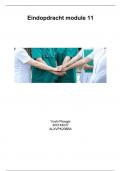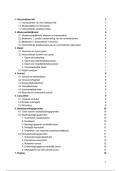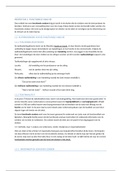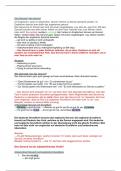ESTADÍSTICA II
DISTRIBUCIONES DE PROBABILIDAD CONTRASTE DE HIPOTESIS NO PARAMETRICOS
Distribución discreta MEDIA MUESTRAL CONTRASTE DE BONDAD DEL AJUSTE
∑ %" (# Prueba CHI-CUADRADO
!! = # = ∑ %" &" !# = ∑ %"# &" ( # = !# − !!# %̅ = B(%̅ ) = # C(%̅ ) = 8 #
Región Crítica / > V8&9&!;
1 1 (T" − B" )# ;
N (#,() para ( # conocida N N(#,() para ( # desconocida /=S k: numero de clases
Distribución continua B" r: parámetros estimados
!
( %̅ − # T" : Frecuencia Observada
$% $% %̅ ~F(#, ) %̅ ~ ~ I'&!
!! = # = ∫&% %. ,(%)/% # ( # = !# − !!# √1 81 /√1 B" : Frecuencia esperada
!# = 0 % . ,(%)/%
&%
B" = 1. &"
VARIANZA MUESTRAL KOLMOGOROV-SMIRNOV
Binomial (n,p) / = max { [6<* − 6(%" )[ , [6<*&+ − 6(%" )[ }
'! ∑(J" − JK)# ∑ %"#
# = 1& ( # = 1&2 3(4 = %" ) = . & ) . 2 '&) A# = A# = − %̅ # 6(%" ): Función de distribución presentada por la hipótesis
)!('&))! 1 1 F"
%! W W
6<* =
1
F" : Frencuencia acumulada
Poisson ~ (XYV Región Crítica / > e';;
&W
, &' ..(
#=5 (# = 5 3(4 = %" ) = 6(%) = 3(4 ≤ %) SHAPIRO-WILK
)! PROPORCIÓN MUESTRAL 3)
? = ∑ >" [ %'&"$! − %" ] h = ∑()* &)̅ ))
Región de Aceptación w >h;
Normal – N(#, ()
&. 2
&̂ ~F(&, M )
1 &
()&0)) 1 CONTRASTE DE INDEPENDENCIA
,(%) = .= #1)
Tabla de contingencias
(√2<
i! i? i9 1" 1" . 1?
Uniforme – U(>, ?) DIFERENCIAS MEDIAS MUESTRALES, POBLACIONES B"? =
j! T!! T!? T!9 1! 1
NORMALES 8
PT"? − B"? R
#
2$3 (3&2)) ! )&2 j" T"! T"? T"9 1"
#= (# = ,(%) = ><%<? 6(%) = /=S
# !# 3&2 3&2 j8 T8! T8? T89 18 B"?
( # conocida ( # desconocida pero iguales !
1? 1! 1? 19 n Región Crítica
'23 '25
(%̅ − N,) − (#6 − #7 ) #
CUASIVARIANZA MUESTRAL (%̅ − NK)~F(#) − #5 , O ~77+9−2 / > V(8&!).(9&!;)
+ ) ;
/ C 1 1
1 2( 4 8∗ #. + /
A!# = A# B(A!# ) =( #
C(A!#) =
1−1 n−1 / C ESTIMACIÓN PUNTUAL
Insesgo Eficiencia Consistencia
CUASIDESVIACIÓN MUESTRAL DIFERENCIAS MEDIAS MUESTRALES, POBLACIONES B(kl ) = k V (kl! ) ≤ V (kl# ) lim BPklR = k
'→%
1 NO NORMALES m=mnoPkl R = BPklR − k lim CPkl R = 0
!V = # ! '→%
1−1 (%̅ − N,) − (#6 − #7 )
~Z(0,1) # !
(1 − D) (Nivel de confianza) M = E(FGH:7IJ !! / !! NIOPI)
2
P213 P15 BrsPkl R = CPkl R + uBPkl R − k v CCR=
# + ^ _` a(b;d) e
E(FGH:7IJ !! /!! GLHJ7I) Error Tipo II / C "#$ % &
^d
D = E(JHGℎIRIJ !! /!! GLHJ7I) (1 − M) (Potencia del contraste)
Error Tipo I ESTIMADOR MÁXIMA VEROMILITUD
E(SHGℎIRIJ !! / !! NIOPI)
DIFERENCIA DE PROPORCIONES
L(X,f)=f(J! , k) … N(J' , k)
CUANTILES N(0,1) Bernoulli X ~ B (1,p) &̂ =%̅ log(I. k) = log(I) + log(k)
&! 2! &# 2# I
P0
Q −0
Q R~F(&! − &# , M + ) #̂ =%̅ log l m = log(I) − log(k)
1 2 Normal X ~ N(7, 9) ∑, ) k
P(Z<a) 1/10 1/8 1/6 1/5 1/4 3/10 1/3 3/8 2/5 / C *-+()* &)̅ )
( #A = log( I; ) = k. log(I)
a -1,28 -1,15 -0,97 -0,84 -0,67 -0,52 -0,43 -0,32 -0,25 '
n<
Poisson X ~ P(:) 5w = %̅ N(+) = log(n) N < (+) =
n
Academia Atica – Academia Nº1 de la URJC – www.academia-atica.com
DISTRIBUCIONES DE PROBABILIDAD CONTRASTE DE HIPOTESIS NO PARAMETRICOS
Distribución discreta MEDIA MUESTRAL CONTRASTE DE BONDAD DEL AJUSTE
∑ %" (# Prueba CHI-CUADRADO
!! = # = ∑ %" &" !# = ∑ %"# &" ( # = !# − !!# %̅ = B(%̅ ) = # C(%̅ ) = 8 #
Región Crítica / > V8&9&!;
1 1 (T" − B" )# ;
N (#,() para ( # conocida N N(#,() para ( # desconocida /=S k: numero de clases
Distribución continua B" r: parámetros estimados
!
( %̅ − # T" : Frecuencia Observada
$% $% %̅ ~F(#, ) %̅ ~ ~ I'&!
!! = # = ∫&% %. ,(%)/% # ( # = !# − !!# √1 81 /√1 B" : Frecuencia esperada
!# = 0 % . ,(%)/%
&%
B" = 1. &"
VARIANZA MUESTRAL KOLMOGOROV-SMIRNOV
Binomial (n,p) / = max { [6<* − 6(%" )[ , [6<*&+ − 6(%" )[ }
'! ∑(J" − JK)# ∑ %"#
# = 1& ( # = 1&2 3(4 = %" ) = . & ) . 2 '&) A# = A# = − %̅ # 6(%" ): Función de distribución presentada por la hipótesis
)!('&))! 1 1 F"
%! W W
6<* =
1
F" : Frencuencia acumulada
Poisson ~ (XYV Región Crítica / > e';;
&W
, &' ..(
#=5 (# = 5 3(4 = %" ) = 6(%) = 3(4 ≤ %) SHAPIRO-WILK
)! PROPORCIÓN MUESTRAL 3)
? = ∑ >" [ %'&"$! − %" ] h = ∑()* &)̅ ))
Región de Aceptación w >h;
Normal – N(#, ()
&. 2
&̂ ~F(&, M )
1 &
()&0)) 1 CONTRASTE DE INDEPENDENCIA
,(%) = .= #1)
Tabla de contingencias
(√2<
i! i? i9 1" 1" . 1?
Uniforme – U(>, ?) DIFERENCIAS MEDIAS MUESTRALES, POBLACIONES B"? =
j! T!! T!? T!9 1! 1
NORMALES 8
PT"? − B"? R
#
2$3 (3&2)) ! )&2 j" T"! T"? T"9 1"
#= (# = ,(%) = ><%<? 6(%) = /=S
# !# 3&2 3&2 j8 T8! T8? T89 18 B"?
( # conocida ( # desconocida pero iguales !
1? 1! 1? 19 n Región Crítica
'23 '25
(%̅ − N,) − (#6 − #7 ) #
CUASIVARIANZA MUESTRAL (%̅ − NK)~F(#) − #5 , O ~77+9−2 / > V(8&!).(9&!;)
+ ) ;
/ C 1 1
1 2( 4 8∗ #. + /
A!# = A# B(A!# ) =( #
C(A!#) =
1−1 n−1 / C ESTIMACIÓN PUNTUAL
Insesgo Eficiencia Consistencia
CUASIDESVIACIÓN MUESTRAL DIFERENCIAS MEDIAS MUESTRALES, POBLACIONES B(kl ) = k V (kl! ) ≤ V (kl# ) lim BPklR = k
'→%
1 NO NORMALES m=mnoPkl R = BPklR − k lim CPkl R = 0
!V = # ! '→%
1−1 (%̅ − N,) − (#6 − #7 )
~Z(0,1) # !
(1 − D) (Nivel de confianza) M = E(FGH:7IJ !! / !! NIOPI)
2
P213 P15 BrsPkl R = CPkl R + uBPkl R − k v CCR=
# + ^ _` a(b;d) e
E(FGH:7IJ !! /!! GLHJ7I) Error Tipo II / C "#$ % &
^d
D = E(JHGℎIRIJ !! /!! GLHJ7I) (1 − M) (Potencia del contraste)
Error Tipo I ESTIMADOR MÁXIMA VEROMILITUD
E(SHGℎIRIJ !! / !! NIOPI)
DIFERENCIA DE PROPORCIONES
L(X,f)=f(J! , k) … N(J' , k)
CUANTILES N(0,1) Bernoulli X ~ B (1,p) &̂ =%̅ log(I. k) = log(I) + log(k)
&! 2! &# 2# I
P0
Q −0
Q R~F(&! − &# , M + ) #̂ =%̅ log l m = log(I) − log(k)
1 2 Normal X ~ N(7, 9) ∑, ) k
P(Z<a) 1/10 1/8 1/6 1/5 1/4 3/10 1/3 3/8 2/5 / C *-+()* &)̅ )
( #A = log( I; ) = k. log(I)
a -1,28 -1,15 -0,97 -0,84 -0,67 -0,52 -0,43 -0,32 -0,25 '
n<
Poisson X ~ P(:) 5w = %̅ N(+) = log(n) N < (+) =
n
Academia Atica – Academia Nº1 de la URJC – www.academia-atica.com


